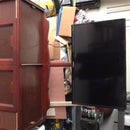Introduction: Infinity LED Mirror
This is an "Infinity" design LED mirror that I constructed several months back. An old Army buddy of mine found a beautiful 4 foot by 2 1/2 foot frame that someone was throwing away, and we decided to make a LARGE version of one of these mirrors!
Step 1: Get You a Nice Frame or Build One Yourself
This is the antique hardwood frame that my buddy got for free! I would definitely recommend a hardwood for the frame, as we will be adding on quite a few components and two HEAVY sheets of glass to get the desired reflective effect. Also, make sure that you plan out the entire build before starting.
Step 2: Get Your LEDs Set Up
Here is the link to the LED light kit I purchased: http://amzn.com/B00ASHQQKI
This kit comes with a power adapter, remote, IR sensor, and 16.4 feet of LED strip w/ adhesive backing for around $30. The LEDs can be trimmed every 1.5 inches or 3 inches depending on which kit you get. I'd recommend getting your LEDs from Amazon or another online distributor, as Home Depot and Lowe's charge a hefty premium for their light strips.
Step 3: Prep the Inside Lip of Your Frame
I sanded the inside lip of the frame here in order to remove any old paint. I repainted it later, but you'll want a nice smooth surface to adhere the LED strip to.
Step 4: Plan the Build Around Your Frame
From here, I measured around the interior dimensions of the frame to determine the length of LED strip I would need.
Step 5: Build a Support Rail for Your Rear Mirror
This step can be tricky. You'll need to account for the thickness of the front pane of glass, which will be "two way" glass. You can purchase this glass from any local glass company, but it can be pricey. Just this front sheet of glass at 4 feet by 2 1/2 feet cost me around 90 dollars! You can also use a two way film, but that may separate over time. The reflective side of this glass should face the REAR of the frame.
After you get the glass, lay it in the front lip of the mirror. From here, place the LED strip around the edge. You'll want your rear mirror to be as close to flush with the LED strip as humanly possible. This will allow the reflection to be more uniform toward the end of the build. I found that buying some corner trim from Home Depot allowed me to build a sturdy support rail with the correct offset. Also, make sure you use construction adhesive (PL375 is what I used) and also screw the rails into the frame from the rear. It's important to note that you will need to countersink the screws into the rail, so your rear mirror is not resting on the screw heads at the end of construction.
Step 6: Install Side Rails; Cut Some Grooves and Holes.
More planning ahead here. Using lengths of oak, I again glued and screwed them on the side of the frame. The reason for this step is to have an offset from the back of the frame and the wall after hanging. It also makes sense to attach your hangers for the mirror to the oak rails instead of the original frame. You can also see more planning here with regard to cutting a channel in the back of the frame for the end of the LED strip. Additionally (not pictured), you can drill a hole through the original frame to run your IR sensor to the front of the mirror. Otherwise, you'll have to have an ugly little wire hanging off the side of your mirror to have the remote work.
Step 7: Install Your LEDs!
Here's something I learned the hard way: the adhesive on the back of these strips is good, but not great, and the strip kept separating from the frame. Since we're going to be enclosing them, it made sense to reinforce this adhesive. I used a 2-part epoxy that mixes in the nozzle and ran a thin bead along the edge of the LED strip to make sure it didn't detach again.
Step 8: Test Your Lights Before Installing the Rear Mirror
Pretty self-explanatory, but important.
Step 9: Install Your Rear Mirror
Having a friend who works for a glass company was INCREDIBLY helpful here. He had the big suction cups, mirror adhesive, and a fancy staple gun that fires brackets to support the rear mirror. Do NOT put any adhesive or silicone on the inside lip of the support rail before you put this rear mirror in! It will detract from the reflective illusion we're going after here. Instead, place the mirror in the rail and use adhesive on the back lip for support.
Step 10: Test Your Finished Product!
This is a short video of the finished product. With the remote, you'll be able to set flashing effects, fade colors, and increase or decrease the brightness of the LEDs.
I hope you enjoyed learning about how to build one of these mirrors; I definitely enjoyed making it!

Participated in the
Green Design Contest

Participated in the
Sensors Contest













